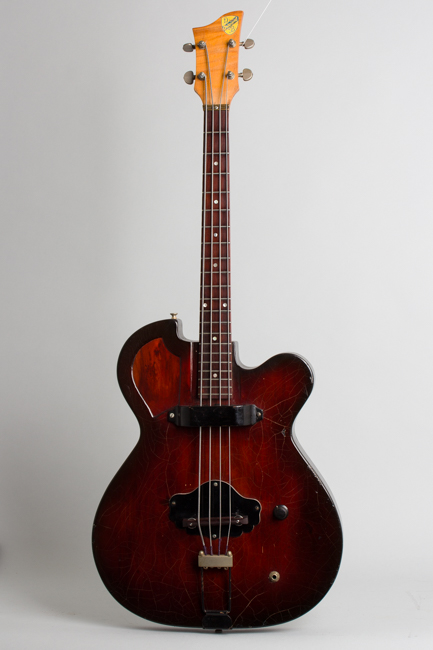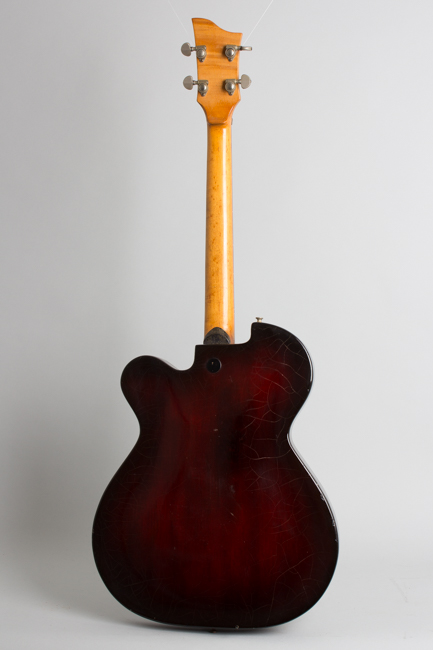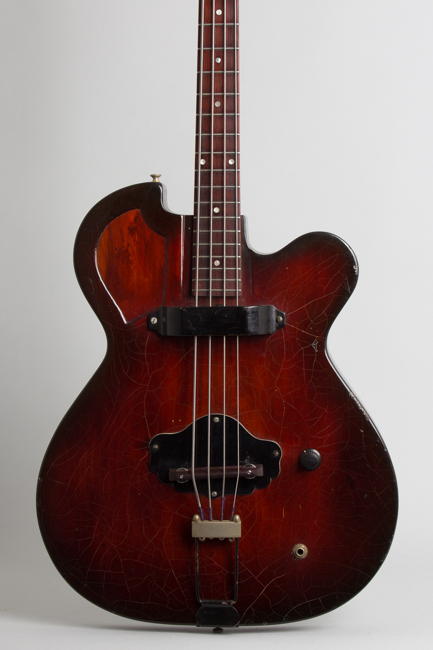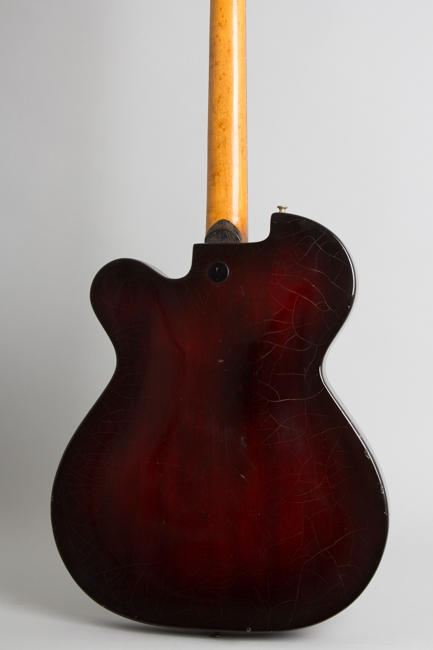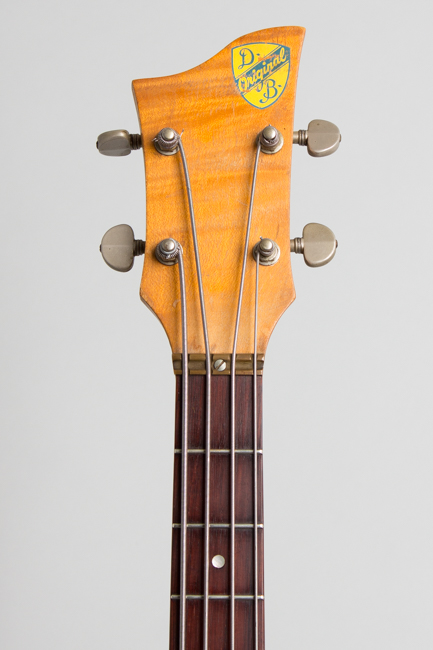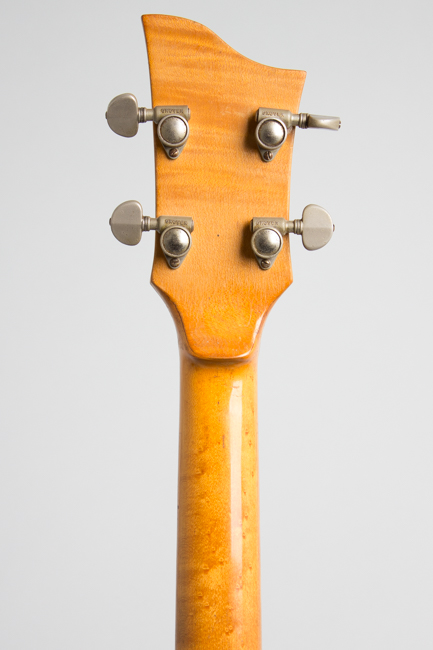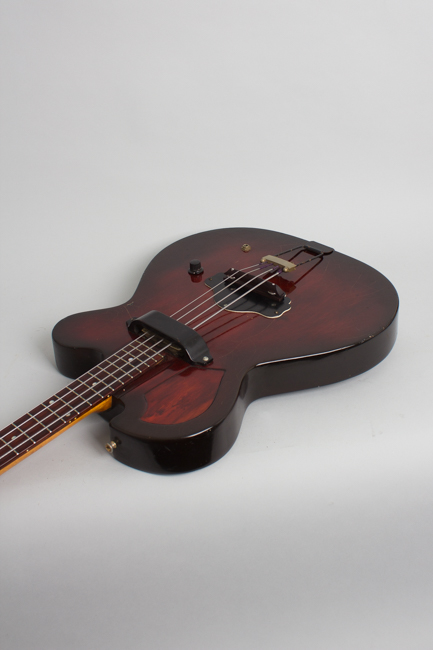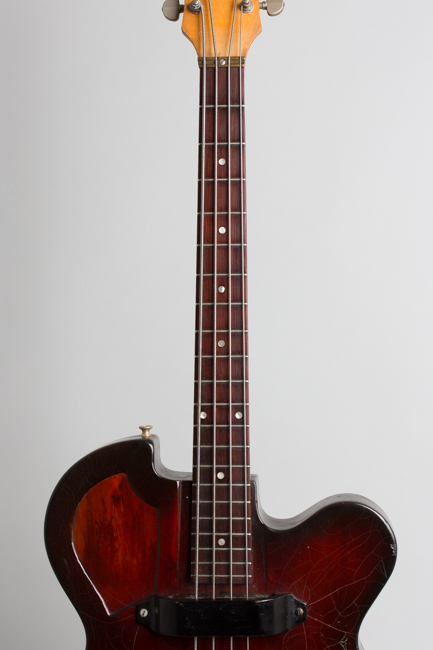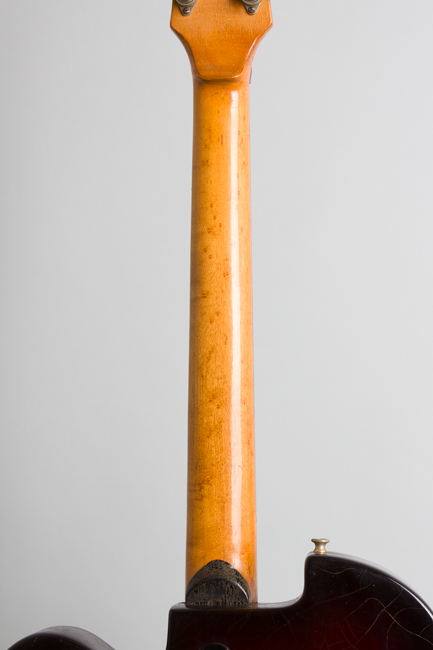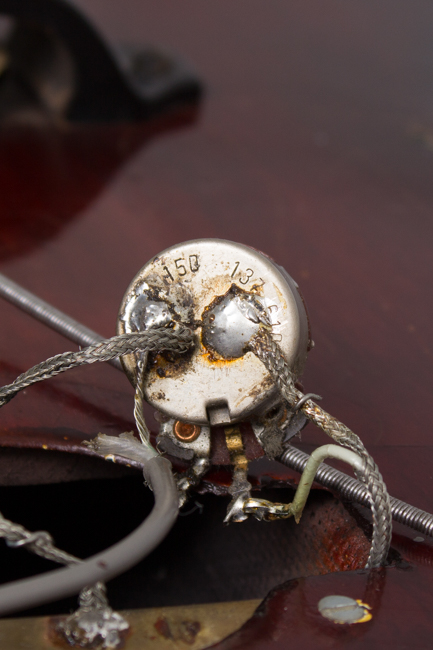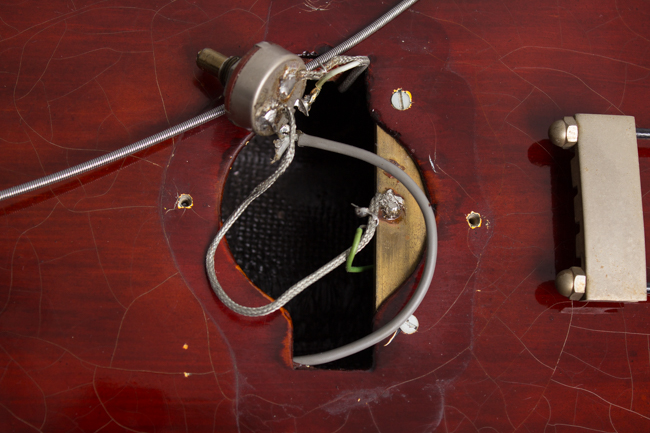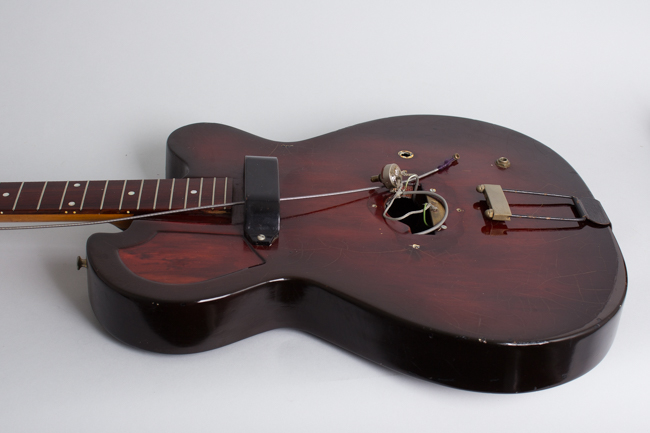Dopyera Brothers DB Original Prototype Hollow Body Electric Bass Guitar , c. 1959
Dopyera Brothers DB Original Prototype Model Hollow Body Electric Bass Guitar, c. 1959, made in Los Angeles, California, dark sunburst woodgrain finish, Fiberglass composite body, maple neck with rosewood fingerboard, black gig bag case.
This is a super unusual, possibly one of a kind electric bass built by some combination of the Dopyera brothers, inveterate tinkerers who together and individually made numerous contributions to guitar history. It has many unusual features, including a VERY short scale wooden neck (a Dopyera specialty) on a body made from fiberglass. There is a hand-made magnetic pickup installed in the neck position, but at some point a version of the Brothers' vibration-activated bass pickup was fitted as well, possibly as an early test case. While it is impossible to date exactly this bass has prototypical features suggesting it may have been a precursor of the National Reso-glas line as well as the pickup of the Brothers' Zorko electric upright bass, a design subsequently sold to Ampeg.
Through various incarnations of National, Dobro and Valco from the 1920s through the 1960s brothers John, Rudy, Emil and Louis Dopyera brought any number of innovations (sometimes brilliant, sometimes quirky) to the fretted world. These include several types of National/Dobro cone resonators, some of the first commercial electric instruments, the earliest guitar with multiple pickups, pioneering Valco's "Reso-Glas" molded fiberglass instruments and many unique pickup and wiring concepts. Not all were successful, but even the dead ends show a unique perspective.
In the late 1950s Louis Dopyera was a senior partner at Valco but his brothers were no longer directly involved. Living together in El Monte, CA John, Emil and Rudy sold occasional resonator guitars under the name DB Original, and introduced fiberglass electric upright basses under the Zorko name. This hand-made bass guitar represents another avenue and is likely a one-off instrument as it is unique in just about every way. The only dated component is a pot coded to the 10th week of 1956, but the Grover Rotomatic tuners used were not generally available until 1958-9. The "DB Original" decal on the headstock dates to this period as well, in use from 1958 into the 1961-2 period.
The semi-hollow body is fiberglass, built in one piece from hand-laid weaves of glass matting. The neck is maple with a rosewood board, carved like Dopera Original banjos with a large screwed-on brass nut. There is an inexplicable extra maple strip laminated under the fingerboard. The bass has a guitar-like 25 1/4" scale, the same as the Valco Pocket bass introduced in 1960. Carvin made the first of these "Guitar-scale" basses followed by Valco, Kay, Mosrite and a few Japanese builders but the idea never worked very well. This bass looks much like a prototype precursor of the Reso-Glas National 85 bass introduced in 1961-2 although the body shape is not fully "map-like" it is generally similar.
The plastic plate under the bridge hides another mystery, a cavity intended to fit some version of the brothers' vibration-sensing pickup developed for the Zorko upright. It is possible this instrument was a test case for that unit in a bass guitar, something Ampeg eventually pursued. Valco did use the "Silver Sound" vibration-activated pickup on basses but that was a surface mount unit. At some point that pickup was removed and the bass is now powered by a rather crude looking single-coil pickup at the neck, screwed to the top under a wooden cover that arches over the strings. There is a single volume control and jack mounted on the top. The strings run over a wooden bridge to what appears to be a re-purposed 1950s Kay bass tailpiece, mostly covered in black paint. The bridge is more recent, but all other hardware appears original.
While details of its 60+ year history are lost, it is undeniable that this bass is the work of one or more of the Dopyera brothers, most likely built as a test instrument for their new-in-the-late '50s ideas. It may indeed be a pre-production iteration of what became the Valco Reso-Glas line, as well as a test case for the Brothers' unique ideas for the electric bass. Obviously Leo Fender had a better plan there, but this is still a fantastic example of a historical 4-string blind alley!
Overall length is 39 in. (99.1 cm.), 15 3/4 in. (40 cm.) wide at lower bout, and 2 1/16 in. (5.2 cm.) in depth, measured at side of rim. Scale length is 25 1/4 in. (641 mm.). Width of nut is 1 9/16 in. (40 mm.).
This one-of-a-kind instrument shows some general wear overall but nothing too serious. There is some spider checking and ding, chips and flakes to the body finish but no structural damage. The neck finish has some light wear, mostly to the headstock while the frets have very little wear; the decal logo has some light flaking. Except for what looks like a fairly recent Harmony Bass style bridge all parts appear original to the instrument. The very short-scale bass plays well with a somewhat brittle sound but really this is primarily a historical piece. It comes with a heavy-duty modern gig bag and a flimsier period one in the pocket. Overall Very Good + Condition.
This is a super unusual, possibly one of a kind electric bass built by some combination of the Dopyera brothers, inveterate tinkerers who together and individually made numerous contributions to guitar history. It has many unusual features, including a VERY short scale wooden neck (a Dopyera specialty) on a body made from fiberglass. There is a hand-made magnetic pickup installed in the neck position, but at some point a version of the Brothers' vibration-activated bass pickup was fitted as well, possibly as an early test case. While it is impossible to date exactly this bass has prototypical features suggesting it may have been a precursor of the National Reso-glas line as well as the pickup of the Brothers' Zorko electric upright bass, a design subsequently sold to Ampeg.
Through various incarnations of National, Dobro and Valco from the 1920s through the 1960s brothers John, Rudy, Emil and Louis Dopyera brought any number of innovations (sometimes brilliant, sometimes quirky) to the fretted world. These include several types of National/Dobro cone resonators, some of the first commercial electric instruments, the earliest guitar with multiple pickups, pioneering Valco's "Reso-Glas" molded fiberglass instruments and many unique pickup and wiring concepts. Not all were successful, but even the dead ends show a unique perspective.
In the late 1950s Louis Dopyera was a senior partner at Valco but his brothers were no longer directly involved. Living together in El Monte, CA John, Emil and Rudy sold occasional resonator guitars under the name DB Original, and introduced fiberglass electric upright basses under the Zorko name. This hand-made bass guitar represents another avenue and is likely a one-off instrument as it is unique in just about every way. The only dated component is a pot coded to the 10th week of 1956, but the Grover Rotomatic tuners used were not generally available until 1958-9. The "DB Original" decal on the headstock dates to this period as well, in use from 1958 into the 1961-2 period.
The semi-hollow body is fiberglass, built in one piece from hand-laid weaves of glass matting. The neck is maple with a rosewood board, carved like Dopera Original banjos with a large screwed-on brass nut. There is an inexplicable extra maple strip laminated under the fingerboard. The bass has a guitar-like 25 1/4" scale, the same as the Valco Pocket bass introduced in 1960. Carvin made the first of these "Guitar-scale" basses followed by Valco, Kay, Mosrite and a few Japanese builders but the idea never worked very well. This bass looks much like a prototype precursor of the Reso-Glas National 85 bass introduced in 1961-2 although the body shape is not fully "map-like" it is generally similar.
The plastic plate under the bridge hides another mystery, a cavity intended to fit some version of the brothers' vibration-sensing pickup developed for the Zorko upright. It is possible this instrument was a test case for that unit in a bass guitar, something Ampeg eventually pursued. Valco did use the "Silver Sound" vibration-activated pickup on basses but that was a surface mount unit. At some point that pickup was removed and the bass is now powered by a rather crude looking single-coil pickup at the neck, screwed to the top under a wooden cover that arches over the strings. There is a single volume control and jack mounted on the top. The strings run over a wooden bridge to what appears to be a re-purposed 1950s Kay bass tailpiece, mostly covered in black paint. The bridge is more recent, but all other hardware appears original.
While details of its 60+ year history are lost, it is undeniable that this bass is the work of one or more of the Dopyera brothers, most likely built as a test instrument for their new-in-the-late '50s ideas. It may indeed be a pre-production iteration of what became the Valco Reso-Glas line, as well as a test case for the Brothers' unique ideas for the electric bass. Obviously Leo Fender had a better plan there, but this is still a fantastic example of a historical 4-string blind alley!
Overall length is 39 in. (99.1 cm.), 15 3/4 in. (40 cm.) wide at lower bout, and 2 1/16 in. (5.2 cm.) in depth, measured at side of rim. Scale length is 25 1/4 in. (641 mm.). Width of nut is 1 9/16 in. (40 mm.).
This one-of-a-kind instrument shows some general wear overall but nothing too serious. There is some spider checking and ding, chips and flakes to the body finish but no structural damage. The neck finish has some light wear, mostly to the headstock while the frets have very little wear; the decal logo has some light flaking. Except for what looks like a fairly recent Harmony Bass style bridge all parts appear original to the instrument. The very short-scale bass plays well with a somewhat brittle sound but really this is primarily a historical piece. It comes with a heavy-duty modern gig bag and a flimsier period one in the pocket. Overall Very Good + Condition.
